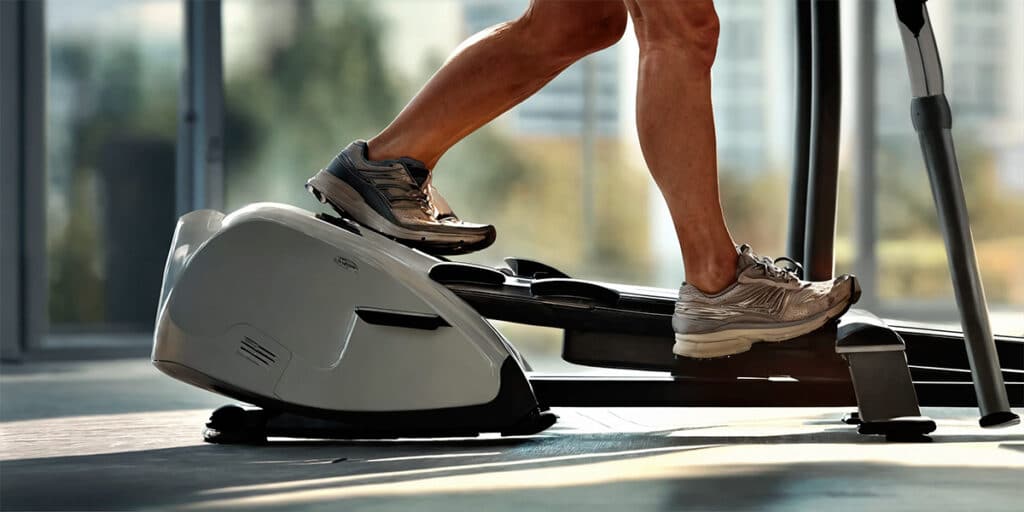Managing diabetes requires a multifaceted approach, with physical activity playing a crucial role. However, finding the right type of exercise that is effective, safe, and enjoyable can be challenging. Low-impact exercise bikes offer an excellent solution, providing a cardiovascular workout that is gentle on the joints and can be easily tailored to individual fitness levels and health needs.
This article explores the benefits of low-impact exercise bikes for individuals with diabetes and how to incorporate them into home workouts for optimal health outcomes.
Why Choose Low-Impact Exercise Bikes?
Low-impact exercise bikes, including stationary bikes, recumbent bikes, and indoor cycling bikes, offer a safe and efficient way to improve cardiovascular health without putting excessive stress on the joints. They are particularly beneficial for individuals with diabetes, as regular aerobic exercise can help regulate blood sugar levels, improve insulin sensitivity, and contribute to weight management.
- Versatility and Accessibility: Low-impact bikes are suitable for all fitness levels, from beginners to advanced athletes, and can be used regardless of the weather or time of day.
- Joint Safety: The smooth motion of cycling reduces the risk of injury and is ideal for those with joint concerns or mobility issues.
- Cardiovascular Benefits: Consistent use helps strengthen the heart and lungs, improving overall cardiovascular health.
Integrating Exercise Bikes into Your Diabetes Management Plan
To maximize the benefits of low-impact exercise bikes for diabetes management, consider the following strategies:
- Set Realistic Goals: Begin with short, manageable sessions and gradually increase the duration and intensity as your fitness improves.
- Monitor Your Blood Sugar: Check your levels before and after workouts to understand how exercise affects your glucose control and make necessary adjustments.
- Stay Hydrated: Proper hydration is essential, especially for individuals with diabetes, to prevent dehydration and ensure optimal performance during workouts.
Choosing the Right Low-Impact Exercise Bike
Choosing the right low-impact exercise bike for your home workouts, especially when managing diabetes, involves more than just picking out the first option you come across. It’s about finding a bike that not only fits your living space and budget but also supports your specific health goals. Here’s a deeper dive into what to consider to ensure you select a bike that meets your needs and enhances your diabetes management plan.
Adjustable Resistance Levels
One of the most critical features to look for in a low-impact exercise bike is adjustable resistance. This functionality allows you to tailor the intensity of your workouts to match your current fitness level while providing the flexibility to increase the difficulty as you get stronger. For individuals with diabetes, this feature is particularly beneficial as it enables a gradual progression in workout intensity, minimizing the risk of low or high blood sugar levels during exercise. Look for bikes that offer a wide range of resistance levels, as this will allow for a more customized and effective workout regimen.
Comfortable Seating
The importance of comfortable seating cannot be overstated, especially if you’re considering a recumbent bike. A well-designed seat can significantly impact your ability to sustain longer workout sessions by ensuring proper posture and reducing strain on your back and joints. For those managing diabetes, consistent and prolonged workouts can be key to improving insulin sensitivity and managing blood glucose levels effectively. Therefore, choosing a bike with ergonomic seating that supports your spine and distributes your weight evenly can make a substantial difference in your overall workout experience and health outcomes.
Built-in Workout Programs and Heart Rate Monitors
To keep your workouts engaging and on track with your diabetes management goals, seek out exercise bikes equipped with built-in workout programs. These programs are designed to simulate various cycling conditions, such as uphill climbs or interval training, providing a dynamic exercise experience that can prevent workout monotony. Additionally, workout programs can help you achieve a more balanced and comprehensive fitness routine, which is crucial for overall health and glucose management.
Equally important is the inclusion of heart rate monitors. Monitoring your heart rate during exercise can ensure you’re working within your target heart rate zone, maximizing cardiovascular benefits without overexertion. For individuals with diabetes, exercising at the correct intensity is essential to avoid sudden drops in blood sugar. Many modern exercise bikes come with heart rate monitors built into the handlebars or are compatible with wireless heart rate chest straps, offering an accurate and convenient way to track your heart rate in real time.
| Feature | Description | Benefit for Diabetes Management |
|---|---|---|
| Adjustable Resistance | Allows the intensity of the workout to be customized. | Enables gradual increase in exercise intensity, important for safely managing blood sugar levels. |
| Ergonomic Design | Design that supports comfortable posture during workouts. | Reduces risk of strain or injury, ensuring consistent workout routine. |
| Heart Rate Monitor | Tracks heart rate in real-time during exercise. | Helps maintain workout intensity within a safe range for individuals with diabetes. |
| Built-in Workout Programs | Pre-set programs that simulate various cycling conditions. | Offers variety and challenge, preventing workout monotony and promoting ongoing engagement. |
| Space Efficiency | Compact design suitable for small spaces. | Facilitates regular exercise by allowing the bike to be easily accommodated at home. |
Safety Tips for Cycling at Home
Ensuring safety while engaging in home cycling workouts is paramount, especially for individuals managing diabetes, where the balance between effective exercise and health considerations is delicate. Adhering to specific safety tips can help mitigate potential risks, allowing for a more enjoyable and beneficial workout. Here’s a closer look at each guideline to maximize safety and effectiveness.
Proper Bike Adjustment
The first step in ensuring a safe cycling session is to adjust the bike settings to match your body’s dimensions. An improperly adjusted bike can lead to strain and discomfort, potentially causing injury over time. Adjust the seat height so that when you’re seated on the bike, your leg has a slight bend when the pedal is at its lowest point. The handlebar height should allow you to maintain a comfortable posture without overreaching or slouching. This alignment helps in reducing the risk of lower back pain, knee strain, and other cycling-related discomforts. For individuals with diabetes, who may have specific physical considerations such as peripheral neuropathy, ensuring proper bike fit is even more critical to avoid undue stress on sensitive areas.
Warm-Up and Cool-Down
Incorporating a warm-up at the beginning of your cycling session gradually prepares your body for more strenuous activity, increasing blood flow to your muscles and reducing the risk of injury. A simple 5 to 10-minute warm-up, consisting of gentle cycling or dynamic stretches, can significantly improve your performance and safety during the workout.
Similarly, a cool-down at the end of your session helps to gradually lower your heart rate and blood pressure, reducing the risk of post-exercise dizziness or fainting, which can be particularly important for those with diabetes. It also facilitates the removal of waste products from your muscles, potentially reducing muscle stiffness and soreness. Cooling down can include several minutes of gentle cycling at a reduced pace followed by stretching exercises that target the muscles used during your workout.
Listening to Your Body
Staying attuned to your body’s signals during exercise is essential for preventing overexertion and injury. Symptoms such as dizziness, nausea, or pain should not be ignored, as they can indicate that you’re pushing yourself too hard or that an adjustment needs to be made in your workout intensity or bike settings. For individuals with diabetes, it’s also crucial to monitor for signs of hypoglycemia (low blood sugar), such as shaking, sweating, or feeling weak and to have a source of fast-acting glucose nearby if needed.
By following these safety tips, you can create a cycling workout routine that is not only effective in aiding your diabetes management but also enjoyable and free from injury. Regularly reviewing and applying these guidelines ensures that each cycling session contributes positively to your overall health and well-being, allowing you to pedal safely and confidently from the comfort of your home.
Low-Impact Bikes for Diabetes Home Workouts: Your FAQs Answered
Why are low-impact exercise bikes recommended for people with diabetes?
They provide a safe, effective cardiovascular workout that can be easily adjusted to individual fitness levels, helping to manage blood sugar without excessive strain on the joints.
How often should I use a low-impact bike for my diabetes management?
Aim for at least 150 minutes of moderate-intensity aerobic activity per week, as recommended by health guidelines for individuals with diabetes.
Can exercising on a low-impact bike help me lose weight?
Yes, combined with a healthy diet, consistent workouts on a low-impact bike can contribute to weight loss by burning calories and improving metabolism.
What should I do if I experience low blood sugar levels during a workout?
Stop exercising, consume a fast-acting carbohydrate, check your blood sugar levels, and rest until you feel better. Consult your doctor for personalized advice.
How do I choose the right resistance setting on my bike?
Start with a low resistance and gradually increase until you’re working hard enough to breathe faster but can still hold a conversation. Adjust as your fitness improves.
Is it necessary to monitor my heart rate while using the bike?
Monitoring your heart rate can help ensure you’re exercising at the right intensity for health benefits without overexerting, especially important for those with diabetes.
What features should I look for in a low-impact exercise bike?
Key features include adjustable resistance, ergonomic design, heart rate monitoring, built-in workout programs, and space efficiency.
How can I stay motivated to continue my bike workouts at home?
Set clear goals, track your progress, vary your workouts with different programs, and celebrate your achievements to keep motivation high.
Can I use a low-impact exercise bike if I have neuropathy?
Yes, but consult your healthcare provider first. Low-impact bikes are generally safe for those with neuropathy, offering a non-stressful way to exercise.
What safety precautions should I take when using my exercise bike?
Ensure the bike is stable and properly adjusted to your size, start with a warm-up, stay hydrated, and listen to your body to avoid pushing beyond your limits.
Citations
- Colberg, Sheri R., et al. “Physical Activity/Exercise and Diabetes: A Position Statement of the American Diabetes Association.” Diabetes Care, vol. 39, no. 11, 2016, pp. 2065-2079. This position statement provides comprehensive guidelines on how physical activity, including cycling, plays a crucial role in managing diabetes, emphasizing the importance of incorporating exercise into daily routines for better glycemic control.
- Boulé, Normand G., et al. “Effects of Exercise on Glycemic Control and Body Mass in Type 2 Diabetes Mellitus: A Meta-analysis of Controlled Clinical Trials.” JAMA, vol. 286, no. 10, 2001, pp. 1218-1227. This meta-analysis highlights the positive effects of exercise, including cycling, on glycemic control and body mass in individuals with type 2 diabetes, underscoring the health benefits of regular physical activity.
- Umpierre, Daniel, et al. “Physical Activity Advice Only or Structured Exercise Training and Association with HbA1c Levels in Type 2 Diabetes: A Systematic Review and Meta-analysis.” JAMA, vol. 305, no. 17, 2011, pp. 1790-1799. This study reinforces the value of structured exercise training, including cycling, for lowering HbA1c levels in individuals with type 2 diabetes, suggesting significant benefits for blood sugar management.
- Church, Timothy S., et al. “Effects of Aerobic and Resistance Training on Hemoglobin A1c Levels in Patients with Type 2 Diabetes: A Randomized Controlled Trial.” The New England Journal of Medicine, vol. 363, 2010, pp. 2233-2241. This randomized controlled trial demonstrates the effectiveness of aerobic exercise, such as cycling, in improving hemoglobin A1c levels, a key indicator of long-term glycemic control.
- Swift, Damon L., et al. “The Role of Exercise and Physical Activity in Weight Loss and Maintenance.” Progress in Cardiovascular Diseases, vol. 56, no. 4, 2014, pp. 441-447. Though not exclusively about diabetes, this article discusses how regular physical activity, including cycling, contributes to weight management, a critical aspect of diabetes management.






